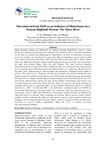| dc.description.abstract | Many Kenyan streams are influenced by humans through disturbances such as water abstraction, farming and grazing in the riparian areas. However, there is limited information on the effect of natural and anthropogenic disturbances on drift, an important ecological process in streams. An investigation to assess the effect of disturbance on invertebrate drift was carried out between December 2015 and July 2016 in the Njoro River, Kenya. Three study sites differing in intensity of observable human and livestock activities were designated for study and included Mugo, Mary Joy and Turkana. The study involved sampling macroinvertebrates in drift and benthos at different study sites, during periods characterized by low and high-water discharge and during different times (i.e., night, day). Results showed that three taxa: Ephemeroptera, Chironomidae and Simuliidae, dominated drift samples at all sites. The study site (i.e., Turkana) with the lowest benthic invertebrate densities had the highest relative invertebrate drift densities (41-70%) during the high discharge period while the study site (i.e., Mugo) with the highest benthic densities portrayed relatively low (6-11%) invertebrate drift densities during the same period. Higher invertebrates drift density was recorded during the night than during the day. Study site location, discharge and time of sampling did not have a significant effect on invertebrates drift density. However, sampler location (i.e., DR1 – in drift and DR2 – out drift) had a significant effect (p=0.0004) on invertebrate drift density in the Njoro River. In conclusion, study site characteristics (e.g., topography - pool or riffle, and disturbance), hydrological regime and time of sampling are important factors to consider when evaluating invertebrate drift in streams. Future studies should consider evaluating the effect of other factors, such as water quality, mining and damming, on invertebrate drift in streams. Water resource managers should put into place measures to prevent further degradation along the river to protect in-stream macroinvertebrate habitats. | en_US |

